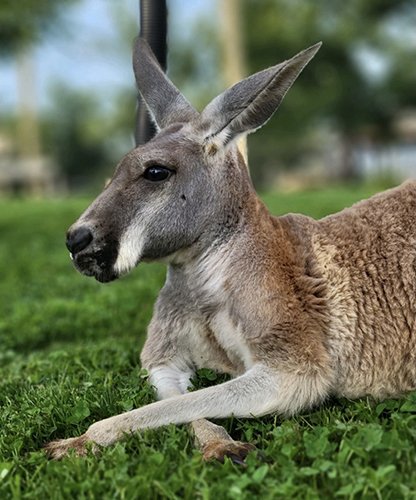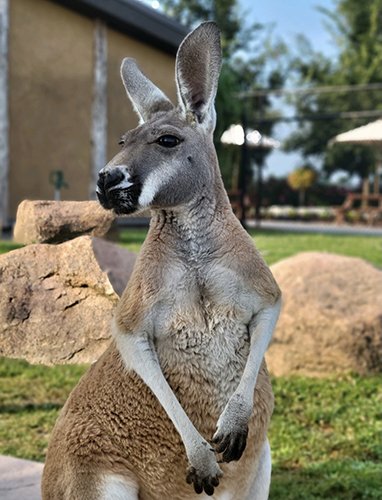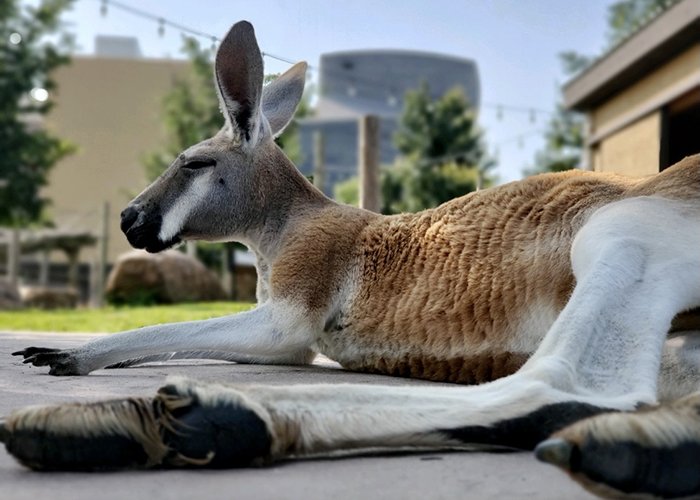Red Kangaroo
Perhaps no animal is more quintessentially Australian than the world’s largest marsupial, the red kangaroo! Males (boomers or jacks) stand up to six feet tall and weigh up to 200 pounds. As marsupials, the females (flyers or jennies) carry their offspring (joeys) in pouches. Red kangaroos live in mobs comprised of a dominant male, his females, and their joeys. The Ararat Ridge Zoo kangaroo walkabout is home to six females: Amira, Naamah, Trinity, Taphath, Ruby, and Emerald.
Red kangaroos are the athletes of Australia. They hop 40 mph, cover 30 feet in a single leap, jump six feet in the air, and swim! Hopping is a very efficient form of movement because kangaroos store 70% of their energy in their tendons (compared to the 20% stored by humans). When their legs are bent at the end of each bounce, energy stored in the tendons springs them into the next hop. Hopping also uses less energy to breathe because when their organs “flop” inside their bodies during each impact, they push air out of their lungs. Kangaroo legs are so powerful that they can kill a dingo with a single kick!
Emerald, our youngest kangaroo, has the zoomies in this video!
Jellybean-sized joeys are born after one-month pregnancies and are blind, deaf, and hairless. Once they crawl inside their mothers’ pouches, joeys complete their development over the next few months. Mother kangaroos sometimes have three joeys at a time—one unborn joey, a younger joey in the pouch, and an older joey out of the pouch. They can produce two types of milk simultaneously: carbohydrate-rich milk for newborns and fat-rich milk for older joeys. Female kangaroos can also pause their pregnancies if they want to. Our kangaroo Naamah did this to us!
When the Ararat Ridge Zoo first opened in 2016, we rented a male named Solomon from another zoo to father some joeys with our original females, Amira and Naamah. After a few years of successful breeding, Solomon was sent back to his home zoo in April of 2018. In the spring of 2019, almost a year later, out popped a little joey from Naamah’s pouch! She was born in December, eight months after Solomon’s departure. Because red kangaroo pregnancies only last one month, Naamah had obviously paused her pregnancy and surprised us with a seventh kangaroo! Her name is Emerald, and she is now the youngest member of our kangaroo mob.
This is a video inside Amira’s pouch, showing her first joey! You will see it is still very small and hairless.
How did the kangaroo kind get to Australia from the mountains of Ararat where the Ark landed (Genesis 8:4)? In Genesis 8:17, God commanded the animals to spread throughout the world. The volcanic activity during and after the flood warmed the oceans and released lots of debris in the atmosphere, creating the perfect conditions for an ice age. Animals likely used land bridges formed during the ice age to cross continents. Animals could also have floated across oceans on log mats formed by all the destroyed forests or even hitchhiked with humans. Since marsupials carry their young on the go, they had an advantage in colonizing faraway locations. That’s likely why there are so many marsupials in Australia!
Watch one of our kangaroos boxing a toy. This is a form of enrichment to encourage exercise and play.
- © 2024 Answers in Genesis
- Privacy Policy
- Contact
- About







